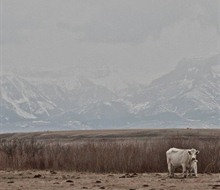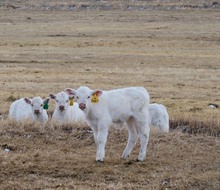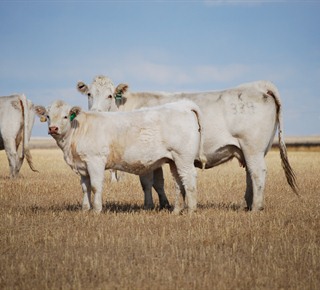How the Cold Affects Newborn Calves
Tue 10 Jan, 2012
Newborn calves are especially susceptible to frigid winter temperatures.
Many times, a newborn calf doesn't have the ability to care for itself, resulting in a wet, cold calf which may not be able to perform the necessary tasks needed to regain warmth or even retain warmth.
Newborn calves start out at a body temperature around 103° F. Within a few hours after birth, it starts to drop off to around 101.5° - 102°, which is a normal body temperature for cattle. However, if the calf’s body temperature drops to below 100° F, it dramatically loses it’s ability to thermo-regulate itself and keep warm.
One of the main conspirators in rapid heat loss is a wet newborn calf. Normally, once the calf is birthed, the mother will proceed to lick the calf which cleans it, as well as dries it off. If the mother neglects to do this, or doesn’t do an adequate job, the calf is left wet. The excess moisture on the calf, combined with cold temperatures and high winds, can induce rapid evaporation and subsequent heat loss.
Most susceptible to chilling, are what we call “high risk” calves. These are calves which experienced a prolonged birth, twins, or calves born to thin or sick cows. These calves may not have enough energy or protein stores to be able to retain warmth. They also might not have as many antibodies due to lowered cellular activity induced by cold temperatures.

Charolais calf well-cared for
The only way to revive these energy and protein stores is for the calf to nurse. It desperately needs the nutrition in the mothers milk, especially colostrum, to kick start cellular activity again, and boost heat production. However, It’s not easy for a chilled cow to nurse because of physical limitations due to the cold. The calves mouth can easily become too cold to nurse, making it impossible for it to suckle. With the most immediate source of nutrition barred from the calf, it’s body begins to use up the little protein stored in the calf’s brown fat reserves, which can be depleted in as little as 1 to 6 days. After these stores are gone, the calf can starve.

Charolais Calf suckling in cold conditions
Suckling has been proven as the most efficient way for a calf to receive nutrition, but when a calf is at risk of starvation, bottle feeding is the best way to combat depletion. A warm bottle of fresh colostrum is the best formula for enhanced nutrition next to the mothers milk. If the calf is too cold to suck, tube feeding of warm colostrum is the next best option. Fresh colostrum is best because it still has the living antibodies in it, which the calf needs to fight infection. However, if fresh isn’t available, frozen will do as well. In a last resort situation, regular warm milk will suffice. Just getting warm liquid into the calf will jumpstart cellular activity, as the calf will retain some of this warmth internally.
Dick Fredrickson, DVM (Grandview, Idaho) says nutrition of the cow makes a big difference in calf survival. “In one study they fed one group of 2 year olds heifers adequate protein and another group received a restricted protein diet. They milked the heifers after they calved, to evaluate colostrum. The heifers that received adequate protein had 2.75 quarts of colostrum and the heifers with low protein intake produced 2 quarts. Then they measured the heat production produced from the colostrum. The colostrum from heifers that received adequate protein produced 118 kilocalories of heat, while the colostrum from restricted diet heifers produced only 104 kilocalories,” he says.

Charolais Calves healthy and happy
“When talking about ways of avoiding cold stress in calves, nearly everything boils down to nutrition of the dam during the final 3 months of pregnancy, and body condition of the cow. If they are not fed adequately during that time, you’ll have more scours, respiratory disease and other illnesses in the calves, and they won’t do as well,” he says.
In this frosty time of the year, proper nutrition plays the most crucial in calf health. Proper nutrition leads to efficient thermo-regulation in calves, which results in a healthy, fast-growing calf.

Charolais cows well-managed year round, receiving proper nutrition to yield healthy, happy, fast-growing calves